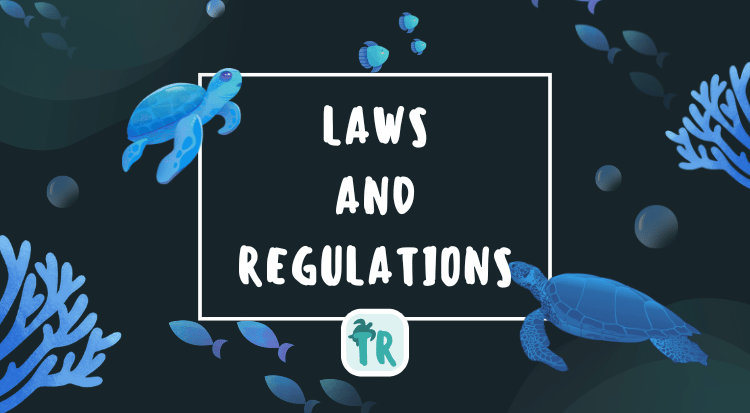Turtle Laws and Regulations in Turtle Conservation
Learn about the laws and regulations that protect turtles worldwide. Understand how international and local laws help conserve turtle species and what you can do to support them.

Laws and regulations play a vital role in protecting turtles and their habitats on a global scale. These legal measures help prevent hunting, trading, and harming of turtles, ensuring their survival for future generations.
This guide will explore the important laws and regulations that safeguard turtles at international, national, and local levels. By understanding and supporting these legal protections, we can all contribute to a larger conservation community and help turtles thrive.
International Laws
International laws set global standards for protecting endangered species like turtles.
Convention on International Trade in Endangered Species (CITES)
- What Is CITES?: An international agreement among governments to ensure that trade in wild animals and plants does not threaten their survival.
- How It Protects Turtles:
- Regulates Trade: Controls the import and export of turtle species.
- Appendix Listings: Turtles are listed in different appendices based on their threat level.
- Impact:
- Reduces Illegal Trade: Helps stop the smuggling of turtles and turtle products.
- Global Cooperation: Encourages countries to work together to protect turtles.
National Laws
Countries have their own laws to protect turtles within their borders.
United States: Endangered Species Act (ESA)
- Purpose: Protects species that are at risk of extinction.
- How It Works:
- Listing Species: Turtles can be listed as endangered or threatened.
- Habitat Protection: Critical habitats are identified and protected.
- Prohibitions:
- No Hunting or Trading: Harming, capturing, or selling listed turtles is illegal.
- Penalties: Fines or jail time for violations.
- Success Stories:
- Sea Turtle Recovery: Some sea turtle populations have increased due to ESA protections.
Other Countries
- Australia:
- Environment Protection and Biodiversity Conservation Act: Protects marine turtles and their habitats.
- India:
- Wildlife Protection Act: Prohibits hunting and trading of turtles.
- Global Efforts:
- National Laws Align with CITES: Countries enforce laws that support international agreements.
Local Regulations
Local governments create additional rules to protect turtles in specific areas.
State and Provincial Laws
- Fishing Regulations:
- Turtle Excluder Devices (TEDs): These are required on fishing nets to allow turtles to escape.
- Protected Areas:
- Wildlife Refuges: Areas where turtles are safe from development and hunting.
- Building Restrictions:
- Coastal Development: Limits on building near nesting beaches.
Municipal Ordinances
- Light Pollution Control:
- Beach Lighting Rules: Reduce artificial lights that confuse hatchling turtles.
- Pet Ownership Laws:
- Permits Required: Some areas regulate owning certain turtle species.
Protection of Habitats
Laws also focus on preserving the places where turtles live.
Marine Protected Areas (MPAs)
- Definition: Sections of oceans where human activity is limited.
- Benefits:
- Safe Feeding Grounds: Protects areas where turtles find food.
- Breeding Sites: Preserves important nesting beaches.
Wetland Conservation
- Importance: Wetlands are vital for many freshwater turtles.
- Legal Measures:
- Ramsar Convention: An international treaty for wetland conservation.
- National Wetland Laws: Protect wetlands from being drained or polluted.
Penalties for Violations
Breaking laws that protect turtles can lead to serious consequences.
Fines
- Financial Penalties: Offenders may have to pay large sums of money.
- Examples:
- Illegal Trading: Heavy fines for selling turtles or their parts.
Imprisonment
- Jail Time: Serious offenses can lead to imprisonment.
- Deterrent Effect: Harsh penalties discourage illegal activities.
Confiscation
- Seizure of Property: Authorities can take illegal goods like turtle shells.
- Rescue of Turtles: Confiscated turtles may be rehabilitated and released.
How Laws Help Turtles
Legal protections have made a positive impact on turtle conservation.
Recovery of Species
- Improved Populations: Some turtle species have shown population increases.
- Success Examples:
- Green Sea Turtles: Numbers have risen in some areas due to protections.
Raising Awareness
- Education: Laws highlight the importance of protecting turtles.
- Community Involvement: Encourages public support for conservation efforts.
How You Can Support Legal Protections
Everyone can play a part in supporting laws that protect turtles.
Stay Informed
- Know the Laws: Understand the regulations in your area.
- Educate Others: Share information with friends and family.
Report Violations
- Contact Authorities: Report illegal activities harming turtles.
- Hotlines: Use designated numbers to inform officials.
Support Advocacy Groups
- Join Organizations: Become a member of conservation groups.
- Participate in Campaigns: Support efforts to strengthen laws.
Conclusion
Laws and regulations are essential tools in the fight to protect turtles. They help prevent illegal activities, preserve habitats, and promote the recovery of endangered species.
By understanding these laws and supporting their enforcement, we can all contribute to turtle survival. Together, our actions make a difference in ensuring these remarkable creatures continue to grace our planet.
